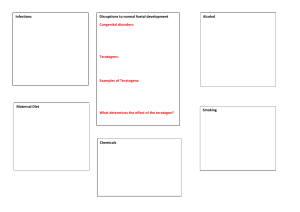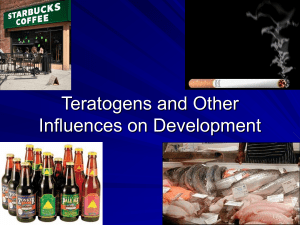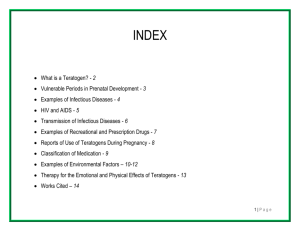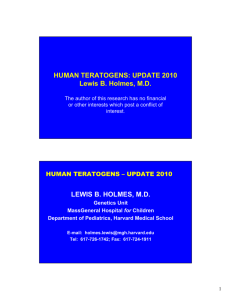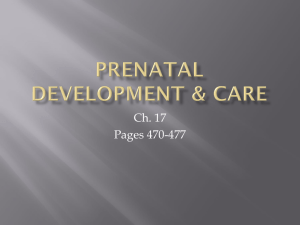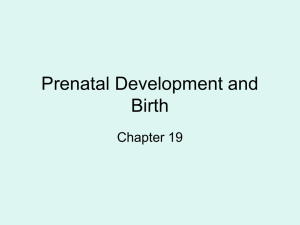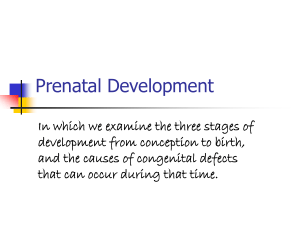Teratogens - University of Puget Sound
advertisement
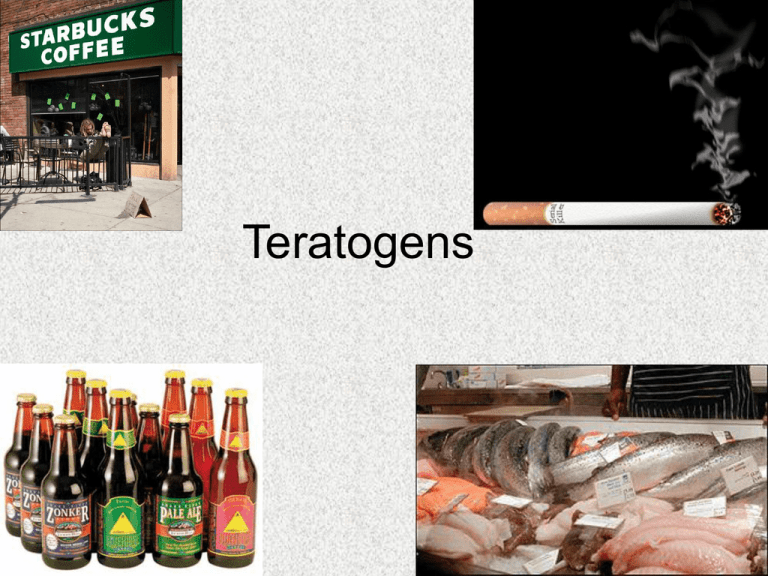
Teratogens Terminology • Defn: any environmental agent that causes damage to the fetus during prenatal period. – viruses, drugs, chemicals, and radiation – others categories? Terminology • 95% of all newborns are normal. Of the remaining 5%, – 3% have mild, temporary or reversible defects. – only 2% having continuing effects. • Effect- What happens- the developmental outcome or consequence of exposure to a teratogen- variation in the development of the embryo, fetus, or child. • Mechanism- How it happens- the physiological or biological processes that explain the cause or how specific events occur Terminology • Sensitive Period- That broad period of time when, if an insult occurs, there are likely to be consequences. – insults may occur over a broad period of time or in a number of ways • e.g., the neurobehavioral effects due to exposure of alcohol during last trimester) • Critical Period- A specific period of time during which, if an insult occurs, a particular consequence will happen – Malformation of ears due to thalidomide exposure on days 34-38 of PND. Characteristics and Effects of Teratogens • Time of exposure – Worst effects= period when a body part or organ system is developing. When is this? – • Susceptibility to harm varies – Not all embryos or fetuses are affected in the same way by the same exposure. • • • Characteristics of the fetus influence the effects Studies with identical twins frequently show that one twin has impairment from a teratogen while the other doesn’t. Research on FAS shows that ½ ounce/day can cause neurobehavioral problems in some children, while some children born to alcoholic mothers don’t get FAS Characteristics and Effects of Teratogens • Different teratogens can cause the same defect (equifinality) – For example: ADHD may be caused by • • • chronic stress experienced by the mother during pregnancy exposure to drugs during pregnancy exposure to alcohol during pregnancy Characteristics and Effects of Teratogens • Single teratogen may cause more than 1 defect (multifinality) – – Rubella may cause blindness, deafness, and mental impairments Exposure to alcohol may cause physical malformations, growth retardation, and mental retardation. Characteristics and Effects of Teratogens • Dose Response (more is worse than less) – FAS- Fetal Alcohol Syndrome • • • – Associated with heavy drinking throughout pregnancy physical malformations may have major mental retardation FAE- Fetal Alcohol Effects • Associated with binge drinking, or occasional drinking- Not as heavy, not as often • Behavioral effects- ADHD, less ability to control emotions Characteristics and Effects of Teratogens • Father’s exposure to teratogens also increases risk WHY?????? – Because sperm take 72 hours to mature and during this period the sperm are susceptible to malformations due to environmental exposures Tetracycline (discolors the enamel of the infant’s teeth). – • Typically associated with mom, but it is also true if dad takes it. Characteristics and Effects of Teratogens • Long-term outcomes can be mediated by postnatal experience – – – – Initial effects seem to be more severe “Effect” may be a susceptibility Long term high quality care and enriched environment helps OVERCOME or minimize bad start HIV Babies with parents who were drug and alcohol users did better than non. WHY?? Environmental Teratogens • • What are they? Methyl mercury- Pollutant found in fish (very high quantities in some areas of Japan) – – Increased birth weight C-Sections Neurobehavioral effects (ADD, ADHD, Learning disorder) Environmental Teratogens • Lead Poisoning- found in old paint and water pipes – – – Anemia- treatable Encephalopathy- abnormal development of the brain & MR Young children and infants who are lead poisoned can get MR- Eating the paint off the walls Social Drugs • Alcohol- 43% of alcoholic mothers have FAS kids (other 57% have FAE) – Full blown FAS: • early exposure (specifically days 19-23)- results in facial dysmorphology- Diagnostic criteria – – – • repeated exposure, throughout pregnancy (early/late) – – – • wide set eyes (small eyes) thin upper lip flat filtrum microencephaly mental retardation (mild to severe) growth retardation (<10% on growth charts) Late exposure (last trimester) – – – Decreased birth weight Hyperactivity Emotional lability (inability to control emotions/lots of emotional outbursts) Social Drugs- Alcohol • MECHANISM- How does it work? – – – – Mom’s ability to metabolize alcohol is reduced during pregnancy- decreases as pregnancy advances breakdown of alcohol uses extra oxygen- reduces the amount that is available to the developing organism- Occurs by collapsing the umbilical cord Alcohol can cross the placenta which impairs embryonic and fetal development Fetus’s ability to metabolize alcohol is 50% of mom’s (so alcohol remains longer at the end of pregnancy) Video- FAE Social Drugs • Smoking (nicotine) – Effects • • • • • • – Decreased birthweight Decreased heart rate Increased carbon monoxide in mom’s system, impairs oxygen exchange and crosses the placenta- Book study increased spontaneous abortions increased perinatal mortality increased hyperactivity, ADHD, ADD Mechanism • reduced oxygen available to the developing fetus • Decreased heart rate and blood pressure Social Drugs • Caffeine- Not as much known. Studies have conflicting results. – – – – Increases heart rate Increases blood pressure Constricts blood vessels Dehydrates, so probably reduces the oxygen supply Illegal Drugs • Marijuana- small numbers of studiesWHY????? – Moms who smoke during pregnancy • • – Attention may be impaired babies are smaller Moms who smoke during pregnancy: • • • – have better parent-infant relationship at 1 month of age have calmer babies Have better social interactions with the infant Problem with the internal validity. Why?? • Self-selected group may have more relaxed view of the world, so therefore have more “lax” relationship with the child Illegal Drugs • Cocaine – Effects: • • • • • – – Decreased gestational age Pre-term, low birth weight Placental abruption Increased rates of birth defects- Malformations of the heart, CNS, gastrointestinal tract Increased hyperactivity, ADD at school age. Mechanism: reduced oxygen supply Recent study with 300 exposed & 300 nonexposed, controlling for SES found that Low SES had a greater effect on the infant development than cocaine. Low B-W and Gest Age • Low birth weight and pre-term birth – – – Low birth weight= < 2500g or 5.5 lbs Pre-term birth = < 35 weeks- Not necessarily bad Influences on the size of the infant • • • • • • Mother’s ht, wt Mother’s age Mother’s weight at birth Environmental variables Nutrition Birth order Birth weight Babies BW 14 40 Maternal Age (in years) • <14 or >40, increased risk Gestational weight, Birth weight, and Survival Low Birth weight & survival Weight at birth 1 – 1 ½ lbs 1 ¾ - 2 lbs 2 ¼ - 3 lbs 3 – 3 ½ lbs >5 ½ lbs Pre-term birth & survival to 1 year Gestational age @ birth <24 weeks 24-25 weeks 26-29 weeks 30-32 weeks 33-36 weeks 37-40 weeks 41+ weeks % survival 33% 67% 84% 91% 98% 35% 63% 86% 93% 98% 99.3% 99.4 %
